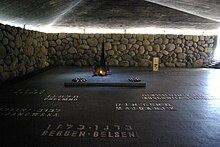Arieh Elhanani
Arieh Elchanani , in languages without the sound ch (IPA χ) also: Elhanani ( Hebrew אַרְיֵה אֶלְחָנַנִי Arjeh Elchananī , partly tooאֶל-חָנַנִי El-Chananī ; born on January 3, 1898 in Poltava , Ukraine , as Leib Saposhnikov, Cyrillic Лейб Сапожников ; died on December 2, 1985 in Tel Aviv , Israel ) was an Israeli architect, graphic artist and sculptor.
Life
Between 1913 and 1917 Elchanani studied art and architecture in Kiev , Ukraine . He took part in the Jewish anthropological expedition led by Salomon An-ski to the Jewish Pale of Settlement . At the beginning of the Russian Civil War in 1917, he was a member of a group of artists who designed propaganda posters in Kharkiv , Ukraine.
In 1922 he emigrated to Palestine . There he produced designs for trade fairs, pavilions, sculptures and logos. He designed the stylized flying camel for the Levante Fair , which was also used on the medals at this fair and is still in use today as the logo of the Israel Trade Fairs & Convention Center . The emblems of the Palmach and the Israel Defense Forces (IDF) are based on his designs .
In 1934 he created the 8-meter-high sculpture of the Hebrew worker in the style of Russian constructivism , one of the few remnants of the past Levant masses. This sculpture was restored in 1989 and is now in Palmer Square in Tel Aviv. The inscription on the steel beam read: "This exhibition with its buildings and pavilions was erected by the Cooperative Construction Office of the United Jewish Workers' Union". Around the sculpture was a shallow pool of water where visitors could meet and rest.
In the 1940s he planned various buildings for the Weizmann Institute for Sciences in Rechovot , later for other educational institutes and public institutions, such as the Bar-Ilan University .
One of his most famous works is the Hall of Remembrance (אֹהֶל יִזְכּוֹר Ohel Jizkōr , German 'tent of the remembering' ) of the Yad Vashem memorial in Jerusalem (together with Arieh Sharon and Benjamin Idelson ). Further commissions were the community auditorium in Kfar Saba , the Gan Ha'ir Tower in Tel Aviv, as well as the Wix Library , the Jacob Ziskind Building (together with Israel Dicker and Uriel Schiller, 1947), the Charles Clore International House (together with Nissan Canaan, 1963), the Stone Administration Building (along with Nissan Canaan, 1966) and the Isaac Wolfson Building (all on the premises of the Weizmann Institute of Science).
In 1973 Arieh Elchanani's achievements were honored with the Israel Prize for Architecture.
The Elchanani Prize of the Bezalel Academy of Arts and Design is named after him.
Individual evidence
- ↑ There are different spellings for the name of this person, both for the first name ( Arieh , Aryeh , Arjeh , Arie ) and for the surname ( Elhanani , Elhanany , El-Hanani , Al-Chanani ). The spelling of the Hebrew pronunciation has been used for the spelling used in this article.
- ↑ נא להכיר: רחבת אריה אל-חנני בנמל ת"א on news1.co.il
- ^ Dalia Manor: Art in Zion: The Genesis of Modern National Art in Jewish Palestine. Google Books, accessed October 9, 2017 .
- ↑ Arieh El-Hanani. Rubin Museum (Israel), 1993, accessed October 9, 2017 .
- ↑ According to the information board at the current location of the sculpture, see commons: Category: The Hebrew Worker
- ^ The Architects. Weizmann Wonder Wander, accessed October 10, 2017 .
- ^ Prizes from the Blanche and Romie Shapiro Department of Fine Arts. Bezalel Academy of Arts and Design Jerusalem , accessed October 10, 2017 .
- ↑ Elhanani, Aryeh. Encyclopedia.com, accessed October 10, 2017 .
Web links
| personal data | |
|---|---|
| SURNAME | Elhanani, Arieh |
| ALTERNATIVE NAMES | Sapozhnikov, Leib (maiden name); El-Hanani, Aryeh; El-Hanani, Arieh; El-Hanani, Arjeh; Elhanay, Arieh; Al-Chanani, Arieh; Elhanani, aria; Elchanani, Arieh |
| BRIEF DESCRIPTION | Israeli architect, graphic artist and sculptor |
| DATE OF BIRTH | January 3, 1898 |
| PLACE OF BIRTH | Poltava , Ukraine |
| DATE OF DEATH | 2nd December 1985 |
| Place of death | Tel Aviv , Israel |


